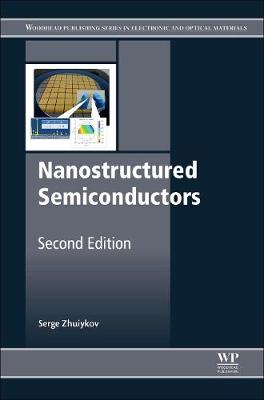Woodhead Publishing Series in Electronic and Optical Materials
1 primary work • 2 total works
Book 53
Nanostructured Semiconductor Oxides for the Next Generation of Electronics and Functional Devices
by Serge Zhuiykov
Published 31 December 2013
Semiconductor oxides are used in electronics, optics, catalysts, sensors and other functional devices. In their 2D form, the reduction in size confers exceptional properties, useful for creating faster electronics and more efficient catalysts. Nanostructured semiconductor oxides for the next generation of electronics and functional devices focuses on the development of semiconductor nano-crystals, their technologies and applications including energy harvesting, solar cells, solid oxide fuel cells and chemical sensors. After an explanation of the physics affecting the conductivity and electron arrangement of nanostructured semiconductors, the book addresses the structural and chemical modification of semiconductor nanocrystals during material growth. It then covers their use in nanoscale functional devices, particularly in electronic devices and carbon nanotubes. The impact of 2D nano-crystals such as graphene, chalcogenides and oxide nanostructures on research and technology is explored, leading to a discussion of incorporating graphene and semiconductor nano-structures into composites for use in energy storage.
The final three chapters focus on the applications of these functional materials in photovoltaic cells, solid oxide fuel cells and in environmental sensors including pH, dissolved oxygen, dissolved organic carbon and dissolved metal ion sensors. Nanostructured semiconductor oxides for the next generation of electronics and functional devices is a crucial resource for scientists, applied researchers and production engineers working in the fabrication, design, testing, characterization and analysis of new semiconductor materials. This book is a valuable reference for those working in the analysis and characterization of new nano-materials and for those who develop technologies for practical devices fabrication.
The final three chapters focus on the applications of these functional materials in photovoltaic cells, solid oxide fuel cells and in environmental sensors including pH, dissolved oxygen, dissolved organic carbon and dissolved metal ion sensors. Nanostructured semiconductor oxides for the next generation of electronics and functional devices is a crucial resource for scientists, applied researchers and production engineers working in the fabrication, design, testing, characterization and analysis of new semiconductor materials. This book is a valuable reference for those working in the analysis and characterization of new nano-materials and for those who develop technologies for practical devices fabrication.
Nanostructured Semiconductors focuses on the development of semiconductor nanocrystals, their technologies and applications, including energy harvesting, solar cells, solid oxide fuel cells, and chemical sensors. Semiconductor oxides are used in electronics, optics, catalysts, sensors, and other functional devices. In their 2D form, the reduction in size confers exceptional properties, useful for creating faster electronics and more efficient catalysts.
Since the first edition of the book, there has been significant progress in the development of new functional nanomaterials with unique and sometimes unpredictable quantum-confined properties within the class what it called two-dimensional (2D) semiconductors. These nanocrystals represent extremely thin nano-structures with thickness of just few nano-meters. Since that time, not only were 2D semiconductor oxides further developed, more importantly, 2D metal dichalcogenides, such as MoS2, MoSe2, WS2, WSe2 and others also progressed significantly in their development demonstrating their superior properties compared to their bulk and microstructural counterparts. The book has been expanded to include these advancements.
The book begins with the structure and properties of semiconductor nanocrystals (chapter 1), addresses electronic device applications (chapter 2), discusses 2-Dimensional oxides and dichalcogenide semiconductors (chapters 3 through 5), and ends with energy, environment, and bio applications (chapters 6 through 8).
Since the first edition of the book, there has been significant progress in the development of new functional nanomaterials with unique and sometimes unpredictable quantum-confined properties within the class what it called two-dimensional (2D) semiconductors. These nanocrystals represent extremely thin nano-structures with thickness of just few nano-meters. Since that time, not only were 2D semiconductor oxides further developed, more importantly, 2D metal dichalcogenides, such as MoS2, MoSe2, WS2, WSe2 and others also progressed significantly in their development demonstrating their superior properties compared to their bulk and microstructural counterparts. The book has been expanded to include these advancements.
The book begins with the structure and properties of semiconductor nanocrystals (chapter 1), addresses electronic device applications (chapter 2), discusses 2-Dimensional oxides and dichalcogenide semiconductors (chapters 3 through 5), and ends with energy, environment, and bio applications (chapters 6 through 8).

